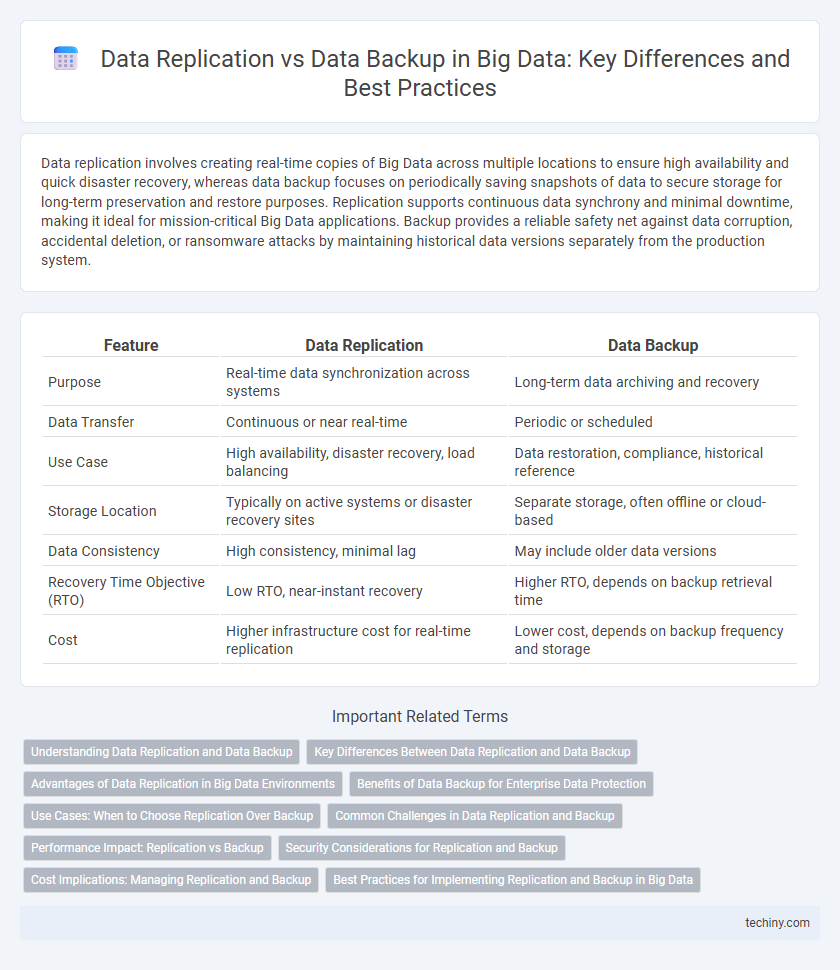Data replication involves creating real-time copies of Big Data across multiple locations to ensure high availability and quick disaster recovery, whereas data backup focuses on periodically saving snapshots of data to secure storage for long-term preservation and restore purposes. Replication supports continuous data synchrony and minimal downtime, making it ideal for mission-critical Big Data applications. Backup provides a reliable safety net against data corruption, accidental deletion, or ransomware attacks by maintaining historical data versions separately from the production system.
Table of Comparison
| Feature | Data Replication | Data Backup |
|---|---|---|
| Purpose | Real-time data synchronization across systems | Long-term data archiving and recovery |
| Data Transfer | Continuous or near real-time | Periodic or scheduled |
| Use Case | High availability, disaster recovery, load balancing | Data restoration, compliance, historical reference |
| Storage Location | Typically on active systems or disaster recovery sites | Separate storage, often offline or cloud-based |
| Data Consistency | High consistency, minimal lag | May include older data versions |
| Recovery Time Objective (RTO) | Low RTO, near-instant recovery | Higher RTO, depends on backup retrieval time |
| Cost | Higher infrastructure cost for real-time replication | Lower cost, depends on backup frequency and storage |
Understanding Data Replication and Data Backup
Data replication involves creating real-time copies of data across multiple servers or locations to ensure high availability and fault tolerance in Big Data environments. Data backup refers to the process of periodically copying and archiving data to separate storage systems to safeguard against data loss or corruption. While replication supports continuous data accessibility, backup provides long-term data recovery and disaster recovery capabilities.
Key Differences Between Data Replication and Data Backup
Data replication involves copying data in real-time or near real-time to ensure high availability and fault tolerance, while data backup refers to creating periodic copies of data for restoration in case of data loss or corruption. Replication supports continuous data accessibility by maintaining synchronized copies across multiple systems, whereas backups are stored as separate file versions that enable recovery from specific points in time. Key differences include replication's focus on system redundancy and failover capabilities, contrasted with backup's emphasis on long-term data recovery and archival storage.
Advantages of Data Replication in Big Data Environments
Data replication in big data environments ensures real-time synchronization across multiple storage systems, enhancing data availability and fault tolerance. It minimizes downtime by enabling continuous data access during hardware failures or maintenance, which is critical for high-velocity data processing. Compared to traditional backups, replication supports faster disaster recovery and load balancing across distributed systems, optimizing performance and reliability in large-scale data architectures.
Benefits of Data Backup for Enterprise Data Protection
Data backup ensures enterprise data protection by creating secure, separate copies of critical information, enabling rapid recovery from hardware failures, cyberattacks, or accidental deletions. Enterprises benefit from automated backup solutions that reduce downtime and maintain data integrity across multiple environments, including cloud and on-premises systems. This robust data protection strategy supports compliance with regulatory standards and safeguards business continuity in the event of data loss.
Use Cases: When to Choose Replication Over Backup
Data replication is ideal for real-time data availability and disaster recovery in distributed systems, ensuring continuous uptime and minimal data loss during system failures. Backup is suitable for long-term data archiving and recovery from accidental deletions or corruption, serving as a historical data snapshot. Choose replication over backup when your use case demands immediate data consistency, minimal latency, and high availability across multiple data centers or cloud environments.
Common Challenges in Data Replication and Backup
Data replication and data backup both face challenges such as data consistency, latency, and storage costs in Big Data environments. Ensuring real-time synchronization across distributed systems can lead to network congestion and increased resource consumption. Furthermore, managing data integrity and recovery speed remains critical to maintaining system reliability and minimizing downtime during failures.
Performance Impact: Replication vs Backup
Data replication ensures high availability and fault tolerance by maintaining real-time copies of data across multiple nodes, enabling faster data access and minimal downtime. Data backup, designed primarily for recovery and archiving, often involves periodic data snapshots that can introduce significant I/O overhead and slower recovery times. Replication minimizes performance impact on production systems by distributing workload, whereas backups may temporarily degrade performance due to resource-intensive processes during backup windows.
Security Considerations for Replication and Backup
Data replication enhances security by ensuring real-time copies of data across multiple nodes, reducing the risk of data loss during cyberattacks but increasing exposure to unauthorized access if replication channels are insecure. Data backup focuses on creating periodic, immutable snapshots that protect against ransomware and accidental deletions, emphasizing encryption and access controls to safeguard stored backups. Implementing comprehensive security measures like end-to-end encryption, multi-factor authentication, and regular vulnerability assessments is critical for both replication and backup processes to maintain data integrity and confidentiality in big data environments.
Cost Implications: Managing Replication and Backup
Data replication incurs higher costs due to continuous real-time data copying, requiring more storage capacity and increased network bandwidth usage. In contrast, data backup typically involves periodic snapshots, reducing storage demands and operational expenses but potentially increasing the risk of data loss between backups. Organizations must balance the cost implications of replication's immediacy with backup's cost-efficiency to optimize data protection strategies in big data environments.
Best Practices for Implementing Replication and Backup in Big Data
Implementing best practices for data replication and backup in Big Data environments involves ensuring data consistency, minimizing latency, and optimizing resource usage. Data replication should be configured for real-time or near-real-time synchronization across distributed nodes to enhance fault tolerance and availability. Regular backup schedules must complement replication by providing point-in-time recovery options, leveraging incremental backup techniques and secure, scalable storage solutions like cloud-based object storage.
Data Replication vs Data Backup Infographic

 techiny.com
techiny.com